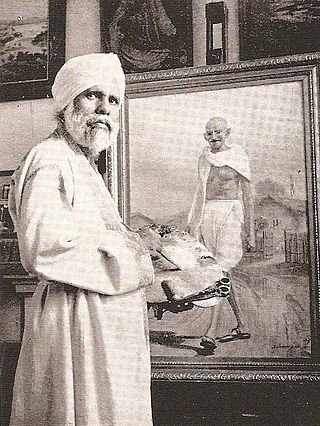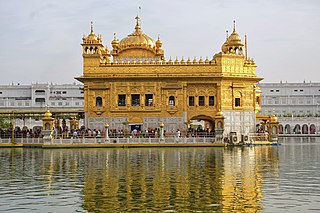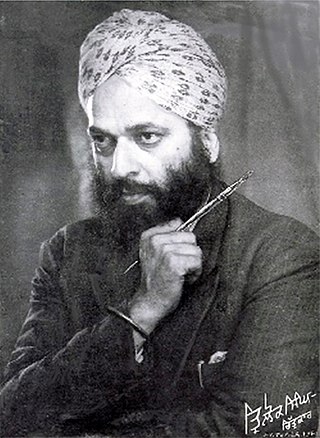
Khalsa College is a historic educational institution in the northern Indian city of Amritsar in the state of Punjab, India. Founded in 1892, the sprawling 300-acre (1.2 km2) campus is located about eight kilometers from the city-center on the Amritsar-Lahore highway, adjoining Guru Nanak Dev University campus, to which Khalsa College is academically affiliated.

Sobha Singh was an artist from Punjab, India.

Baba Deep Singh is revered among Sikhs as one of the most hallowed martyrs in Sikhism. He is remembered for his sacrifice and devotion to the teachings of the Sikh Gurus. Baba Deep Singh was the first head of Misl Shaheedan Tarna Dal – an order of the Khalsa military established by Nawab Kapur Singh, the then head of Sharomani Panth Akali Buddha Dal. The Damdami Taksal also state that he was the first head of their order.

Abdur Rahman Chughtai was a painter, artist, and intellectual from Pakistan, who created his own unique, distinctive painting style influenced by Mughal art, miniature painting, Art Nouveau and Islamic art traditions. He is considered to be 'the first significant modern Muslim artist from Pakistan', and the national artist of Pakistan.

S. G. Thakur Singh (1899–1976) was an Indian artist who painted in oils, pastels and water colour. He worked in the Indian film industries located in Bombay and Calcutta. He was acquainted with members of the Bengal renaissance movement of art, such as Nand Lal Bose and the Tagore brothers. Although he had been familiar with traditional Sikh methods of art created by his predecessors, he preferred modern methods and was not influenced by the indigenous methods. He was permanently patronized and paid a commission by many Indian royal houses, such as Kota, Udaipur, Bhopal, Kashmir, Dongarpur, Travancore, Nawan Nagar, Bikaner, Patiala, Kapurthala, and several other Indian princely states. Ordhendra Coomar Gangoly was his appreciative critic.

Devender Singh is a contemporary Indian artist (painter) from Punjab.

The Bhangi Misl was a large and powerful Sikh Misl headquartered in Amritsar. It was founded in the early 18th century by Sardar Chhajja Singh Dhillon, who was baptised by Banda Singh Bahadur. The misl received its name "Bhangi" because Chhajja Singh and his soldiers frequently used the herbal intoxicant bhang. It was a first misl to established a Khalsa Raj and publish Khalsa currency coins. The Bhangi Kingdom/Misl was founded by Dhillon Jats.

The Golden Temple (also known as the Harmandir Sahib, or the Darbār Sahib, is a gurdwara located in the city of Amritsar, Punjab, India. It is the pre-eminent spiritual site of Sikhism. It is one of the holiest sites in Sikhism, alongside the Gurdwara Darbar Sahib Kartarpur in Kartarpur, and Gurdwara Janam Asthan in Nankana Sahib.

Sardar Kapur Singh (1909–1986) was an Indian civil servant in Punjab and later a politician belonging to Shiromani Akali Dal. He was a Sikh intellectual, and wrote about Sikh religion and politics. He was also the author of the Anandpur Sahib Resolution of the Akali Dal in 1973, demanding rights of Punjab and the Sikh community. Singh was proficient in multiple languages including English, Punjabi, Persian, Arabic and Sanskrit.
Sikh art, also known as the Sikh School, is the artwork created by or associated with Sikhs and Sikhism. Sikh artwork exists in many forms, such as miniature, oil, and watercolour paintings, murals, and wood carvings.

Trilok Singh Chitarkar (1914-1990) was a versatile Indian painter. He has unique style of presenting himself through variety of themes - Sikh religion, history, culture, folk lore, love legends, portraits, social evils, nature, illustration of Gurbani, Shabads, visuals in Punjabi Encyclopedia and books. He was well versed with deep knowledge of Gurbani, history and religion. He knew many languages i.e. Gurmukhi, Punjabi, Hindi, English, Urdu, Persian, Assamese and Bengali. He translated articles from Bengali to Punjabi and published these in the book titled Bangla De Daab in 1974. The Artist was honoured in 1973 by the Chief Minister, Punjab,India Giani Zail Singh at a state level function organised at his residence, Chitralok, Patiala. Language department, Punjab published a book in Punjabi-Chitralok's Contribution to Art and released on the 70th birthday of the artist, 10 December 1984 at a special function organised in Central Library at Patiala for his contribution to Art.

G. S. Sohan Singh was a Punjabi Sikh artist who specialized as an oil-colourist. He was an influential Sikh artist who developed the Sikh school of oil-paintings, realism, and block-making.

Gian Singh Naqqash was a Punjabi Sikh artist who specialized in naqqashi and mohrakashi methods. He was a fresco painter and worked at the Golden Temple for more than 33 years. He is particularly known for painting in the style that is known as the Sikh School of Painting. He was notable for localizing Sikh art by developing a local Punjabi style that was disassociated from the Pahari style, specifically the Kangra variety, and Iranic art styles, which had influenced Punjabi and Sikh art prior. Gian Singh achieved this by incorporating local Punjabi features, dress, and settings in the depicted figuratives. Later-on in his life, he was awarded and recognized by the S.G.P.C. for his artistic efforts.

August Theodor Schoefft was a 19th-century Hungarian painter. He spent more than one year in the Sikh Empire, arriving in 1841, where he painted portraits and scenes of the surrounding area. His best known works include The Court of Lahore and Maharaja Ranjit Singh at Darbar Sahib. A painting by Scheofft sold at Christie's for over £91,250 in 2009.

Sikh painting is a form of Sikh art style spread from Punjab Hills to the Punjab Plains which flourished between the 18th to 19th centuries. Major centres for the art school was Lahore, Amritsar, Patiala, Nabha, Kapurthala and Jind. Artists from surrounding regions migrated to Punjab seeking patronage for varying reasons. Most depicted scenes in Sikh painting are of Sikh gurus, portrait of chiefs of the states and court scenes. In the later period the artists painted popular traders of bazaar, such as cobbler carpenter, blacksmith etc. Considering the geographic boundaries were changing frequently in that period and the artists were generally migrants, there is always an overlap between Pahari styles such as Kangra and Guler with the Sikh style.

Bishan Singh, also known as Baba Bishan Singh, was a Sikh painter whom achieved high-acclaim during his life. Much of his surviving works depicts scenes from the Sikh Empire and prominent figures of the era. His paintings have sold for large sums at auction.

Kishan Singh (1836–1895), also known as Kishan Singh of Lahore, was a Sikh painter who specialized in mussawir. He was born into a Ramgarhia family and was the brother of Bishan Singh. Kishan Singh had been employed as a court painter in the Sikh states of Kapurthala and Patiala. Kishan Singh was employed by royal courts located in Amritsar, Kapurthala, and Lahore. Whilst working in Lahore, Kishan Singh helped facilitate the arrival of other artists.

Kehar Singh (1820–1882) was a Sikh artist who was employed as a court painter by the Sikh states of Lahore and Kapurthala. Baba Kehar Singh Musawar was a prominent artist of the Sikh Naqqashi school of art and helped innovate it. The art of frescoes was introduced by the artist Bhai Kehar Singh Musawar under the patronage of Maharaja Ranjit Singh during the era of the Sikh Empire.

Bhai Jawahir Singh Kapur was a leading figure of the Singh Sabha Movement, specifically the Lahore Singh Sabha. He was a social reformer, a civil worker, a poet, writer and proponent of the Khalsa Diwan (Lahore).

Lahora Singh was a Sikh artist. He was the disciple of Mohammad Bakhsh Musawar, whom was the father of Khalifa Imam-ud-din. Early in his career, Lahora Singh worked in the Gumti Bazār, the artists' quarter of Lahore, but later would shift his base-of-operations to Dabbi Bazār in Lahore. Whilst based in Gumti Bazār, Lahora worked alongside Abdur Rahman Chughtai. Lahora was also commissioned by the rulers of Sikh states, such as Patiala and Kapurthala. During the time of partition in 1947, disturbances in the city led to Lahora's studio in Gumti Bazār burning-down, leading to the loss of many of his works. As a result, surviving works of Lahora are rare today. Lahora had a disciple named Milkhi Ram.




























